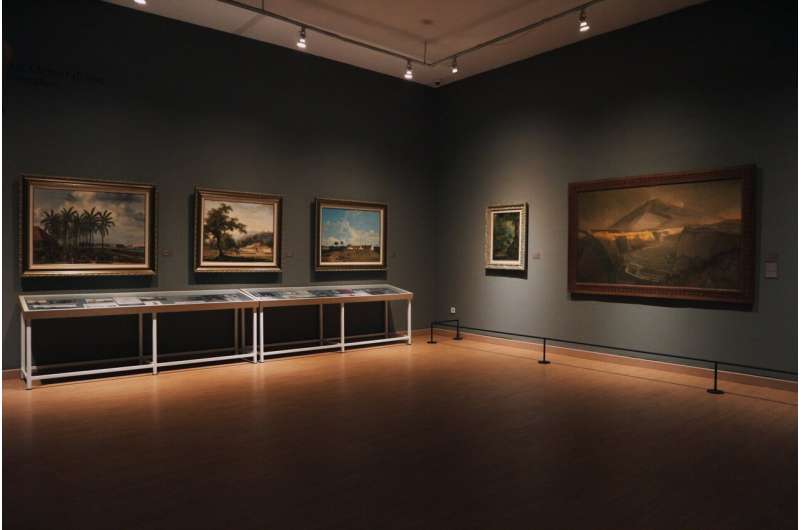This article has been reviewed according to Science X's editorial process and policies. Editors have highlighted the following attributes while ensuring the content's credibility:
fact-checked
trusted source
proofread
Art philanthropy in US is localized, depends on prestige of art organization, research finds

Wealthy individuals and entities have been known to fund the arts since ancient times.
The Ming dynasty, the Medici family, Madame de Pompadour, Gertrude Stein and Peggy Guggenheim have played pivotal roles in the creation and preservation of famous artwork throughout history.
Most contemporary art institutions in the United States continue to depend on private funding. The Metropolitan Museum of Art in New York City reported receiving more than $250 million in philanthropic support in 2018, while the Museum of Fine Arts in Boston reported more than $60 million in philanthropic support, representing almost half of their total respective revenues.
The majority of art institutions operate on limited budgets. Government grants contribute a modest 15% to art museums' annual budgets.
Northeastern's Center for Complex Network Research used its network science tools to develop a detailed quantitative picture of philanthropic art funding to find the patterns that govern private giving and help art organizations fundraise more efficiently.
The researchers found that the number of grants given to an art organization strongly correlated with the prestige of that institution and that almost half of the donors awarded more than 50% of grants in their own state. While art institutions enjoy a high donor retention rate (almost 70% after one year), high localization of philanthropic funding can make organizations compete for donors both within the same art genre and with other genres.
"I was quite surprised by the locality of the art funding," says Albert-László Barabási, Robert Gray Dodge professor of network science, university distinguished professor and director of the Center for Complex Network Research. "We have seen that before in the science funding space, but art felt more universal, implying that if you're interested in a particular kind of art institution you should easily cross state boundaries."
In order to quantify donor-recipient relationships in art, Barabási and his co-author, Louis Shekhtman, former postdoctoral researcher in network science at Northeastern, analyzed tax forms 990 and 990PF filed electronically by 685,000 nonprofits and publicly shared by the IRS.
"The art world functions inherently as a network that includes different kinds of players, including artists, institutions, curators and critics," Barabási says. "Network science offers a way to map out and understand in a quantitative way these networks so that the fruits of this research become available to all players."
The study narrowed its focus to 49,000 art nonprofits that secured $36 billion in grants from 47,000 foundations between 2010 and 2019.
The research established a strong correlation between institutional prestige of the art organizations and funding, with the top 10 most prestigious institutions averaging more than 1,000 grants each in that decade and more than $100 million. Lower-prestige institutions received between dozens and a few hundred contributions or between $100,000 and $10 million in total.
In 2018 alone, the Met, one of the largest museums in the world, received contributions from the highest number of U.S. donors—1374—more than any other art institution. Many donors of other major New York City-based institutions, Shekhtman says, also donated to the Met. For example, the Leon Levy Foundation reported giving $229,000 to the Museum of Modern Art in 2019 and $162,000 to the Met.
The geographical proximity of the recipients and donors of philanthropic funding played a significant role in the distribution of grants, according to the study results. A considerable portion of philanthropic donations to art institutions—61% of dollars and 56% of the number of grants—occurs on a local level, Shekhtman says, even for major national foundations.
For example, almost 50% of the art organizations receiving support from the MacArthur Foundation and the Ford Foundation are in Illinois and New York, respectively, while more than 50% of art institutions sponsored by the Getty Trust are in California. Many private foundations, Shekhtman says, have an exclusively local focus.
"The local piece highlights the role of local connections and the experiential aspect of art, when visiting the museum leads someone to become a donor," Shekhtman says.
Such localization of funding, the scientists say, raises concerns about fairness and equitable allocation of resources between different geographical areas and communities. As most wealthy foundations supported by big national and international business enterprises are based in already wealthy areas of the U.S., they say, the redistribution of this wealth to local institutions can exacerbate existing inequalities.
Art is not the main focus for the most philanthropic foundations, Shekhtman says.
Donors whose philanthropic focus is in other fields, the research suggests, are often open to giving a portion of their funds to art. When different organizations attempt to fundraise from the same donor, Shekhtman says, the donor might give a higher fraction of their assets to art overall. For the same reason, art organizations should also try to reach out to the major donors in their region who have never previously donated to art.
The study also found a high donor retention rate in the art world, with nearly 70% of relationships continuing into the second year and 90% after seven years of consistent giving.
"There's been a lot of thought in sociology and other fields about what makes someone donate and how it is important," Shekhtman says. "A lot of what we found was very consistent with that, but we have quantified [these patterns] in a much more specific and rigorous way."
Provided by Northeastern University
This story is republished courtesy of Northeastern Global News news.northeastern.edu.



















